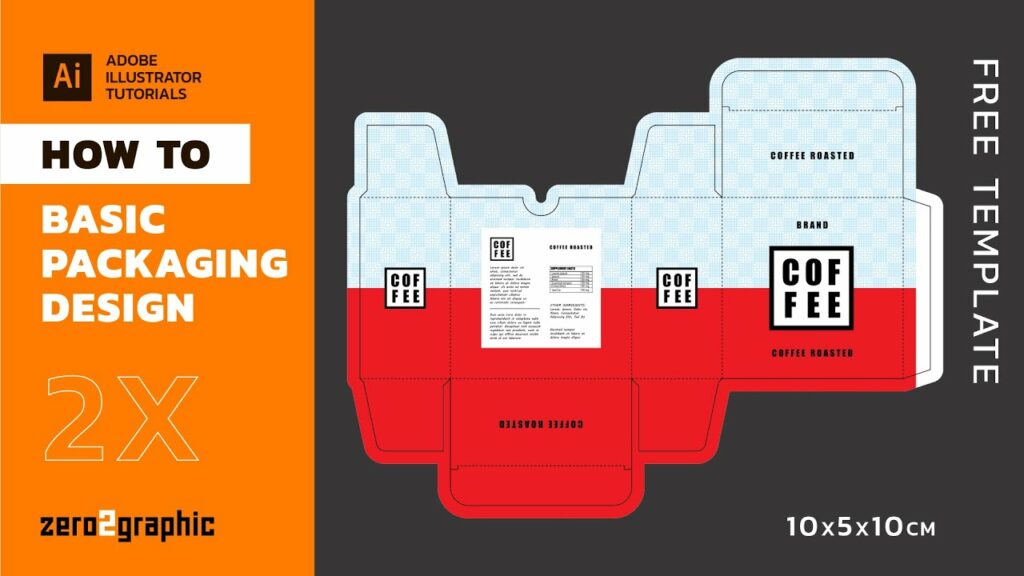Mastering Product Packaging Design: A Comprehensive Guide to Crafting Striking Vector Illustrations in Adobe Illustrator

Introduction: Product packaging serves as a visual representation of a brand’s identity and plays a crucial role in attracting consumers and influencing purchasing decisions. Vector illustrations on product packaging not only enhance aesthetic appeal but also communicate key messages and brand values effectively. Adobe Illustrator, with its powerful vector-based tools and extensive features, provides designers with the perfect platform to create captivating illustrations for product packaging. In this comprehensive guide, we’ll delve into the step-by-step process of creating vector illustrations for product packaging in Adobe Illustrator, covering everything from conceptualization to final production.
Section 1: Understanding Product Packaging Design 1.1 The Significance of Product Packaging: Explore the importance of product packaging as a marketing tool, conveying brand identity, product information, and emotional appeal. 1.2 Role of Vector Illustrations: Examine the role of vector illustrations in product packaging design, enhancing visual impact, storytelling, and brand recognition. 1.3 Types of Product Packaging: Discover different types of product packaging, including boxes, labels, pouches, and bottles, and their respective design considerations.
Section 2: Planning Your Vector Illustration 2.1 Defining Objectives: Determine the purpose and goals of your vector illustration, whether to communicate product features, evoke emotion, or differentiate from competitors. 2.2 Audience Analysis: Consider the demographics, preferences, and expectations of the target audience to tailor your illustration effectively. 2.3 Research and Inspiration: Gather inspiration from existing packaging designs, artistic styles, and thematic elements to inform your creative direction and conceptualization.
Section 3: Getting Started with Adobe Illustrator 3.1 Overview of Adobe Illustrator: Familiarize yourself with the Illustrator workspace, tools, and essential features for creating vector illustrations. 3.2 Setting Up Your Document: Create a new document in Illustrator, specifying the dimensions, resolution, and color mode suitable for your product packaging project. 3.3 Organizing Layers and Artboards: Utilize layers and artboards to organize your illustration elements systematically, facilitating efficient design and editing workflows.
Section 4: Designing Vector Illustrations 4.1 Sketching Your Concept: Begin by sketching rough ideas and concepts for your vector illustration, focusing on composition, visual elements, and brand messaging. 4.2 Creating Base Shapes: Use basic shapes and paths to outline the main elements and structures of your illustration, establishing the foundation for further detailing. 4.3 Adding Details and Textures: Enhance your vector illustration with intricate details, textures, and visual effects using Illustrator’s drawing tools and effects palette.
Section 5: Color and Branding 5.1 Selecting Color Palette: Choose a color palette that aligns with the brand identity, product theme, and target audience preferences, considering factors such as color psychology and brand recognition. 5.2 Branding Integration: Incorporate brand logos, icons, and typography seamlessly into your vector illustration, reinforcing brand identity and product recognition. 5.3 Creating Visual Hierarchy: Establish a visual hierarchy within your illustration, emphasizing key elements such as product features, benefits, and call-to-action messages.
Section 6: Finalizing and Exporting Your Illustration 6.1 Reviewing and Refining: Conduct thorough reviews of your vector illustration, making necessary adjustments and refinements to composition, colors, and details. 6.2 Adding Finishing Touches: Apply final touches such as highlights, shadows, and gradients to polish your vector illustration and enhance visual appeal. 6.3 Exporting Files for Printing: Prepare your vector illustration for printing by exporting it in the appropriate file format and resolution, considering factors such as print size and color profiles.
Section 7: Printing and Production 7.1 Choosing Printing Methods and Materials: Evaluate various printing methods, substrates, and finishing options suitable for your product packaging project, balancing quality, cost, and durability. 7.2 Working with Print Vendors: Collaborate effectively with print vendors, providing accurate specifications and files to ensure the successful production of your product packaging. 7.3 Quality Control and Distribution: Perform quality checks on printed samples, ensuring color accuracy, print clarity, and overall satisfaction before distributing or launching your product packaging.
Conclusion: Creating vector illustrations for product packaging in Adobe Illustrator offers designers a dynamic platform to showcase their creativity while effectively communicating brand identity and product messaging. By following the comprehensive steps outlined in this guide, you’ll be equipped to create captivating illustrations that elevate product packaging and resonate with consumers. So, unleash your creativity, embrace the possibilities, and embark on your journey to design vector illustrations that captivate and inspire consumers worldwide.




